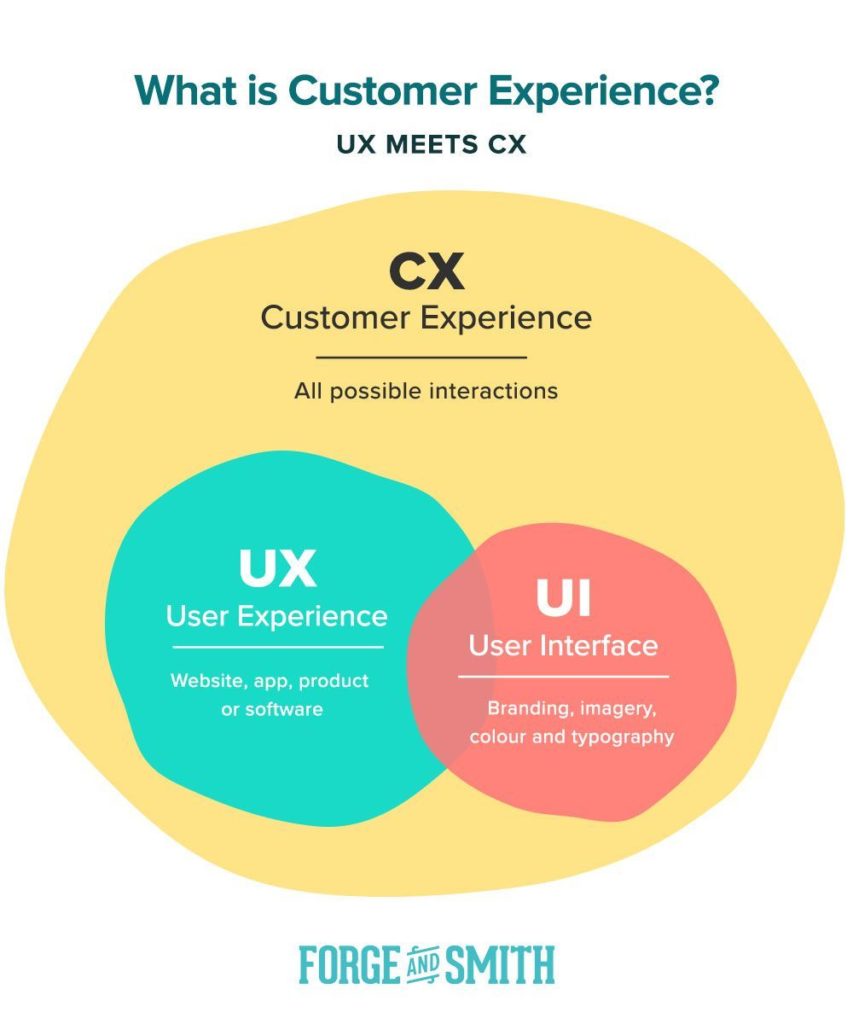Lessons in Design Thinking: #1 The difference between CX, UX & UI
In eCommerce, there’s a lot of technical abbreviations and buzzwords that often become muddled and misinterpreted over time — and it’s no different when talking about design.
In our years working with online brands; Customer Experience (CX), User Experience (UX) and User Interface (UI) are the most common terms that seem to mean different things to different people. The confusion is understandable given the rapid evolution of vocabulary and meaning in step with maturing digital design practices.
However, it’s important to recognise that while they’re closely connected, each term refers to a distinct layer of the whole customer-business relationship. By understanding the role each one plays, and applying well designed solutions across them all, a more useful, usable, and enjoyable experience can be achieved that will in turn drive up KPIs.
We’ve found that the simplest way of explaining the connection and differences between the three terms is through the use of this diagram:

Forge and Smith, 2020
User Interface: UI refers to the content and controls a customer will see and interact with on a particular step of their buying journey. This includes components like the links and buttons the user clicks to view and configure products; the form fields they fill out at checkout to complete a purchase; and the help tip they read to solve a problem.
The design of the UI directly affects the usability. Consideration is given to visual styling and screen composition so that each interface is inherently easy to comprehend and act on.
User Experience: UX is often the term that is commonly confused (partly because it has been superseded in some respects by Customer Experience). When we talk about UX with our own clients, we use it to describe the journey across a single channel, which in our case, is the customer’s buying journey on an eCommerce store.
A User Experience typically encompasses multiple User Interfaces. UX design describes how these individual interactions correlate with one another to create a journey which has congruent messaging, smooth hand-offs, and engaging moments for your customer.
A common misconception is that UX only relates to the eCommerce site and ends at the checkout. At this point, your user has interacted with all of your digital UI’s and successfully purchased – but it doesn’t end there. Your UX also describes the experience your customer’s receive afterwards; including the confirmation email, the delivery, possible comms with customer services, and maybe a return.
All of these are part of the wider brand journey, but crucially, a user experience is confined only within a single channel. Therefore, a user can have multiple user experiences with the same brand, particularly if you’re an omni-channel retailer i.e. UX of online store vs UX of Physical Store.
Customer Experience: CX is best thought of as the sum of all touch-points a brand has with its customers, across all channels, throughout the lifetime of the relationship. As a UX is made up of multiple UI, likewise the CX is composed of different UX.
This means that if you do have physical stores, they need to be considered as part of your customer experience. A customer does not see a physical store and an online store as two separate channels – they will have a holistic view of one experience from one brand. As an example; a negative experience on your online channel will affect their perceptions of your physical stores – no matter how helpful your customer advisors are or how beautiful your visual merchandising is! This becomes crucial if your brand operates services such as Click & Collect.
In reverse of the above example, it’s not good for your CX if you have a fantastic website but a poor delivery service in-store.
The same is true for online deliveries – a 3rd party delivery driver who arrives late or with damaged goods is going to affect your Customer Experience and brand reputation, no matter how much you’ve invested in your online store.
Design at this level is more strategic and revolves around aligning the various brand touchpoints by coordinating the people and processes behind them. Consistent propositions, messages, and standards are some of the outcomes from investing in CX.
Why are we covering the basics?!
Another common misconception: Web Development agencies should only consider the website…wrong! A good eCommerce agency will work with you to audit the entire Customer Experience, because although the User Interface can be re-designed to drive more conversions amongst new customers, no repeat customers will be coming back to a brand who had a poor delivery or returns experience.
With our own clients, we take this broader perspective of how the web store fits into the wider business in order to find your true pain-points and support you in improving on a broader scope. This means that we are also able to aid you in writing a brief that will help you address your key challenges, thus realising higher ROI.
Key Takeaway here: Understand how UI and UX relate to the overarching Customer Experience, and that to run a successful online store, you need to be investing in design at each level — not just making quick UI fixes!
If you’re a merchant looking to improve your customer experiences, get in touch with our Head of Design, Joseph Russell, about our Discovery Workshops: Joe@wearejh.com